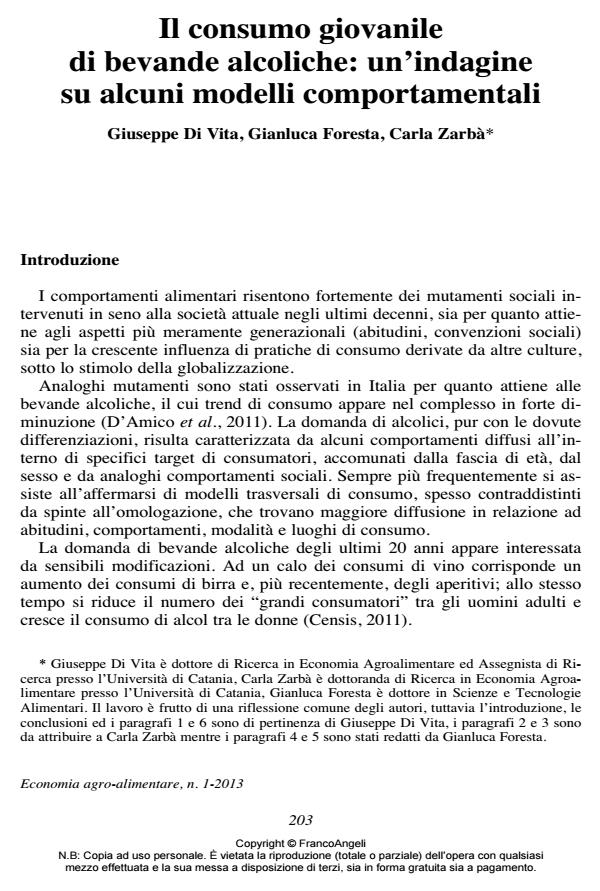Il consumo giovanile di bevande alcoliche: un’indagine su alcuni modelli comportamentali
Titolo Rivista ECONOMIA AGRO-ALIMENTARE
Autori/Curatori Giuseppe Di Vita, Gianluca Foresta, Carla Zarbà
Anno di pubblicazione 2013 Fascicolo 2013/1
Lingua Italiano Numero pagine 30 P. 203-232 Dimensione file 1016 KB
DOI 10.3280/ECAG2013-001010
Il DOI è il codice a barre della proprietà intellettuale: per saperne di più
clicca qui
Qui sotto puoi vedere in anteprima la prima pagina di questo articolo.
Se questo articolo ti interessa, lo puoi acquistare (e scaricare in formato pdf) seguendo le facili indicazioni per acquistare il download credit. Acquista Download Credits per scaricare questo Articolo in formato PDF

FrancoAngeli è membro della Publishers International Linking Association, Inc (PILA)associazione indipendente e non profit per facilitare (attraverso i servizi tecnologici implementati da CrossRef.org) l’accesso degli studiosi ai contenuti digitali nelle pubblicazioni professionali e scientifiche
In the last decade an increese in of alcoholic beverage consumption outside mealtimes has been observed all over Italy, especially amoung young people over a wide age-range. Although the Italian culinary tradition is closely related to the wine consumption, high levels of market penetration by beer and other alcoholic beverages has been recorded. This study into the main trends in alcoholic beverage consumption within a specific segment of the youth population aims at interpreting the susceptibility of young consumers regarding such products. In particular, the purpose of the study is to identify the motivational choices and patterns of consumption amongst college students concerning to main forms of alcoholic beverage (wine, beer and spirits) through a descriptive analysis of intergroup behavior; for this purpose, the sample has been split according to demographic criteria (sex and age). The consumption of wine take place mainly in the domestic sphere and during meals, while beer consumption is prevalently non-domestic (in pubs and bars) and take place outside mealtimes, although there is some domestic consumption. The other alcoholic beverages follow a specific consumption model in social gatherings outside the home, in pubs and discos in particular. Finally, some hypotheses about decision-making and collective consumption of alcoholic beverages have been tested. The results show widespread consumption of these alcoholic drinks among young people. The data regarding the population sampled seems to indicate that choice and consumption behaviour are both induced by interaction with individuals of one’s own group (social dimension) and by experiential activities.
Parole chiave:Intergroup behavior, young consumers, social identity, wines and spirits Consumption
Jel codes:Q13, M3
Giuseppe Di Vita, Gianluca Foresta, Carla Zarbà, Il consumo giovanile di bevande alcoliche: un’indagine su alcuni modelli comportamentali in "ECONOMIA AGRO-ALIMENTARE" 1/2013, pp 203-232, DOI: 10.3280/ECAG2013-001010